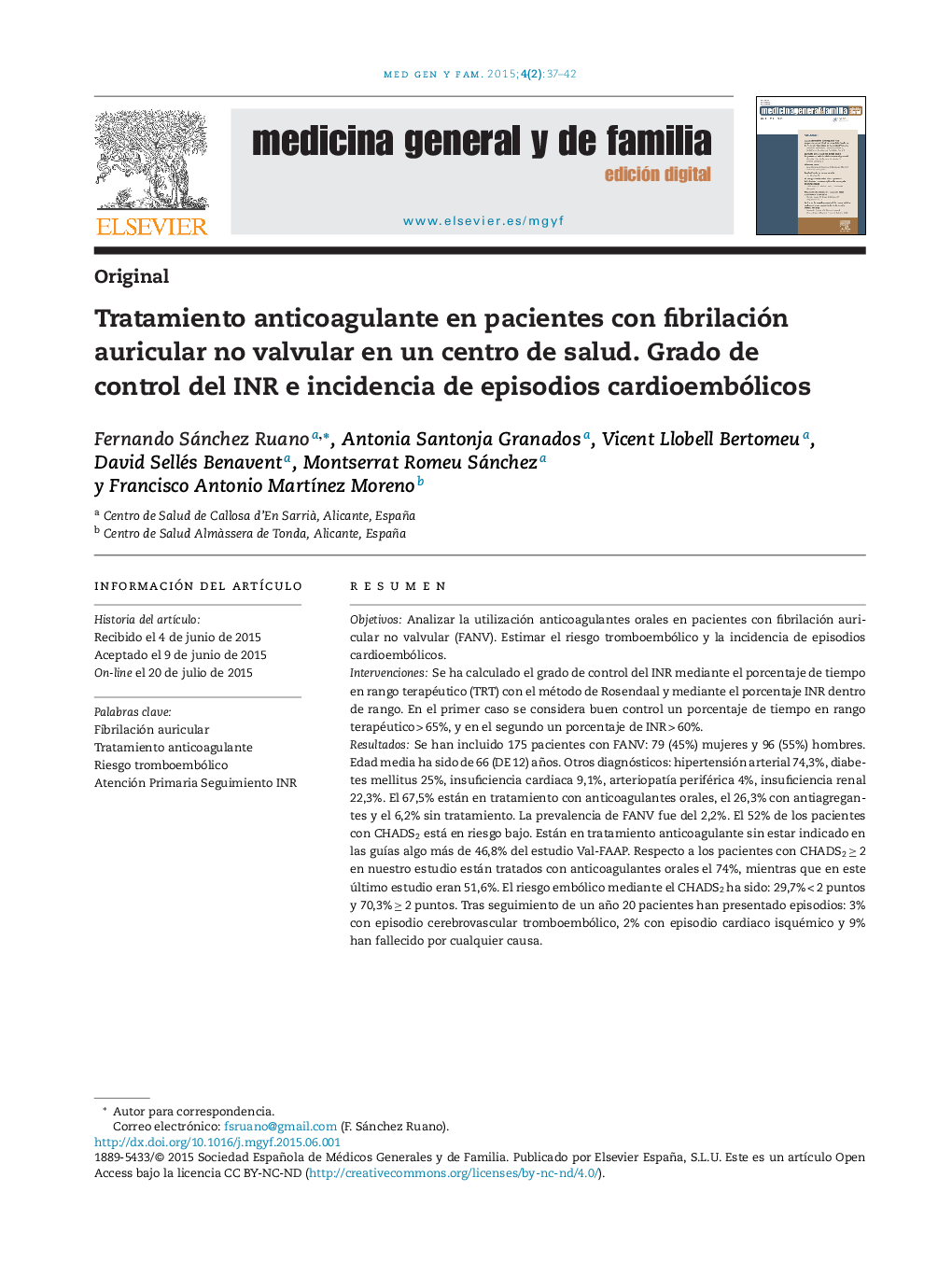| کد مقاله | کد نشریه | سال انتشار | مقاله انگلیسی | نسخه تمام متن |
|---|---|---|---|---|
| 3803541 | 1244923 | 2015 | 6 صفحه PDF | دانلود رایگان |

ResumenObjetivosAnalizar la utilización anticoagulantes orales en pacientes con fibrilación auricular no valvular (FANV). Estimar el riesgo tromboembólico y la incidencia de episodios cardioembólicos.IntervencionesSe ha calculado el grado de control del INR mediante el porcentaje de tiempo en rango terapéutico (TRT) con el método de Rosendaal y mediante el porcentaje INR dentro de rango. En el primer caso se considera buen control un porcentaje de tiempo en rango terapéutico > 65%, y en el segundo un porcentaje de INR > 60%.ResultadosSe han incluido 175 pacientes con FANV: 79 (45%) mujeres y 96 (55%) hombres. Edad media ha sido de 66 (DE 12) años. Otros diagnósticos: hipertensión arterial 74,3%, diabetes mellitus 25%, insuficiencia cardiaca 9,1%, arteriopatía periférica 4%, insuficiencia renal 22,3%. El 67,5% están en tratamiento con anticoagulantes orales, el 26,3% con antiagregantes y el 6,2% sin tratamiento. La prevalencia de FANV fue del 2,2%. El 52% de los pacientes con CHADS2 está en riesgo bajo. Están en tratamiento anticoagulante sin estar indicado en las guías algo más de 46,8% del estudio Val-FAAP. Respecto a los pacientes con CHADS2 ≥ 2 en nuestro estudio están tratados con anticoagulantes orales el 74%, mientras que en este último estudio eran 51,6%. El riesgo embólico mediante el CHADS2 ha sido: 29,7% < 2 puntos y 70,3% ≥ 2 puntos. Tras seguimiento de un año 20 pacientes han presentado episodios: 3% con episodio cerebrovascular tromboembólico, 2% con episodio cardiaco isquémico y 9% han fallecido por cualquier causa.ConclusionesLa prevalencia de FANV es del 2,2%. Dos tercios de los pacientes están tratados con anticoagulantes orales. Algo más de la mitad de los pacientes con CHADS2 está en riesgo bajo. Están en tratamiento anticoagulante sin estar indicado en las guías algo más del 46,8% del estudio Val-FAAP. Serán necesarios estudios a largo plazo que evalúen la incidencia de complicaciones como mejor parámetro de la efectividad real del sistema.
ObjectivesTo determine the use of oral anticoagulants in patients with non-valvular atrial fibrillation (NVAF), and to estimate the thromboembolic risk and the incidence of cardio-embolic episodes.InterventionsThe control of INR was calculated using the therapeutic range time (TRT) with the Rosendaal method and using the percentage of INR within the range. In the first case, a TRT >65% was considered good control, and in the second a percentage INR > 60%.ResultsThe study included 175 patients with NVAF: 79 (45%) women and 96 (55%) men. The mean age was 66 years (SD 12). The other diagnoses were, arterial hypertension 74.3%, diabetes mellitus 25%, heart failure 9.1%, peripheral arterial disease 4%, and renal failure 22.3%. Over two-thirds (67.5%) were on treatment with oral anticoagulants, 26.3% on anti-platelet drugs, and 6.2% with no treatment. The prevalence of NVAF was 2.2%. Just over half (52%) of the patients with CHADS2 were at low risk, and were on anticoagulant treatment that is not indicated in the guidelines, somewhat more than the 46.8% of the Val-FAAP study. As for patients with CHADS2 ≥ 2, 74.1% were treated with oral anticoagulants in our study, while in this latter it was 51.6%. The embolic risk using CHADS2 was < 2 points, 29.7%, ≥ 2 points 70.3% After 1 year of follow-up, 20 patients had presented with episodes: 3% of nthe total with a thromboembolic vascular episode, 2% with an ischaemic cardiac episode, and 9% had died from any cause.ConclusionsThe prevalence of NVAF is 2.2%. Two-thirds of patients were treated with oral anticoagulants. Around half of the patients with CHADS2 are at low risk, and were on anticoagulant treatment that is not indicated in the guidelines, somewhat more than the 46.8% of the Val-FAAP study. Long term studies are required in order to evaluate the complications rate as a better parameter to measure the real efficacy of the system.
Journal: Medicina General y de Familia - Volume 4, Issue 2, April–June 2015, Pages 37–42